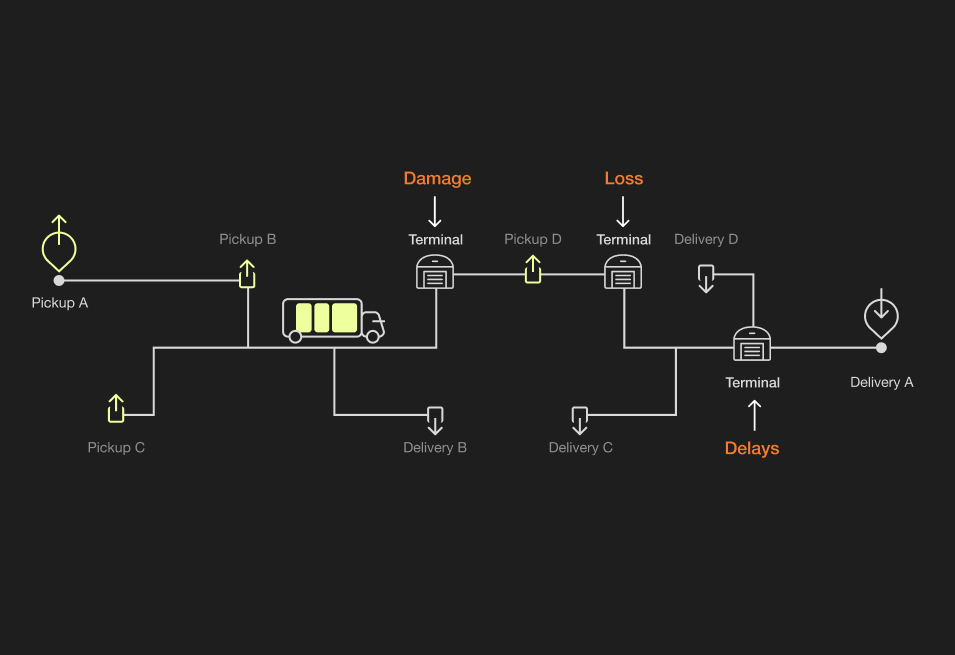How to Optimize Inbound & Outbound Logistics

Properly optimizing your logistics operations can immediately impact your business’s profit margins, customer satisfaction, and ability to scale. Whether you are looking to close the gaps in your inbound logistics or better meet customer demand via outbound logistics, examining your current processes for opportunity is critically important to stay competitive.
Inbound vs outbound logistics
There are distinct differences between inbound and outbound logistics, and it’s important to be well-versed in the differences between the two. Here’s what you should know:
Inbound logistics ensures raw materials arrive at the warehouse.
Inbound logistics refers to the overall process and network that brings goods to your business. It includes multiple steps such as knowing how much raw material to source, coordinating suppliers, and storing materials efficiently. Finished goods and materials are then processed or packaged into products that are sold and delivered to customers. Examples of inbound logistics include:
- sourcing raw materials (plastics, wood, or concrete) that are eventually combined to create a finished product
- transporting products or parts from a warehouse or storage facility to a business
- storing finished products to be sent to customers once they are purchased
Outbound logistics ensures finished products are delivered on time to a customer’s home or storefront.
Outbound logistics, on the other hand, refers to the transportation, storage, and delivery systems that bring your products to your customers. Instead of focusing on raw materials and suppliers, outbound logistics involves choosing the best carriers and systems to get your finished product to your customers without issue. Outbound logistics deals with freight logistics, tracking, and consolidation.Examples of outbound logistics include:
- fulfilling customer orders and preparing for shipment
- coordinating the consolidation of shipments for multiple customers into a single shipment
- tracking last mile delivery of a product to a customer’s home
The differences between inbound and outbound logistics include not only the flow of freight, but also the necessary processes and tools. Additionally, each type of logistics presents its own distinct challenges for your business.
Challenges in inbound logistics
There are several challenges in inbound logistics that can negatively impact costs, delay production, and ultimately hinder a business’s ability to meet customer demand. Some of the most common examples include:
- Hidden fees: lack of visibility on accessorial fees can make it difficult for businesses to stay on budget
- Insufficient data collection: if the right data isn’t collected, it’s more challenging to pinpoint supply chain issues and improve inbound processes
- Slowed response times: storage inefficiencies can result in major gaps in response time and production following sudden increases in receivables
- Inefficient inventory management: failure to maintain accurate inventory counts or to rearrange inventory in a First In, First Out (FIFO) fashion can result in spoilage or damage
- Poor supplier reliability: issues with supplier reliability, such as shipment tracking inconsistencies or lack of status updates, can lead to production delays and eventually negatively impact outbound logistics
How to optimize inbound logistics
Inbound logistics should be analyzed regularly to uncover opportunities to optimize processes, eliminate inefficiencies, and lower costs. Ensuring clear communication between suppliers and manufacturers and proper management of raw materials is key. Some opportunities to optimize inbound logistics include:
- Combine deliveries: consolidating your inbound shipments can improve efficiency at your distribution centers by setting more predictable schedules and reducing congestion
- Build relationships with suppliers: choose suppliers who share your high standards and commitment to excellence, then be consistent with your communication, timely with your feedback, and open to their constructive criticism
- Automate more processes: automating your warehousing and inventory control systems can standardize processes and keep operations smooth
Challenges in outbound logistics
Outbound logistics carries its own set of challenges for business owners looking to meet increasing customer demands while remaining under budget. Any number of logistics issues may surface in the outbound supply chain, such as:
- Inefficient shipping routes: poor freight routing via the hub-and-spoke system can result in costly damage and delays
- Missing delivery deadlines: lack of reliable drivers, as well as with warehouse efficiency and storage issues, can make it difficult to meet delivery expectations
- Complex regulations: some organizations lack the time and expertise to ensure compliance with complex freight regulations
- Lack of coordination with carriers: poor communication between shippers and carriers can result in fewer OTIF deliveries, reduced transparency with customers, and long-term gaps in the supply chain
- Damaged delivery: damaged goods result in increased costs and decreased customer satisfaction as well as diminished trust in a carrier
- High transportation costs: market fluctuations can unexpectedly impact transportation costs, so it’s up to shippers to keep costs down in areas they control
How to optimize outbound logistics with Flock Freight
While many companies choose to outsource logistics, optimizing your outbound logistics can still be done effectively in-house by utilizing companies like Flock Freight. With Flock, you can optimize your outbound logistics by:
- Reduce freight transportation costs: choosing any freight mode that fits your load—truckload, LTL, shared truckload (STL), or partials—helps you find the most cost-effective transportation for each shipment
- Reduce damage on freight: your STL shipment travels terminal-free—resulting in 5.7x less damage than LTL
- Meet delivery deadlines: our proprietary algorithm finds and fills empty spaces on trucks and chooses an optimized delivery route that eliminates the delay-prone hub-and-spoke model
- Maintain visibility on freight: view and track shipments in real time to better inform your entire logistics process
- Choose reliable carriers: access our network of vetted carriers to ensure your shipments get truckload-quality service no matter the size
Relying on tools like Flock Freight to optimize your logistics process can contribute to reduced costs, improved efficiency, and ultimately business growth. Find out more and join the Flock today.





